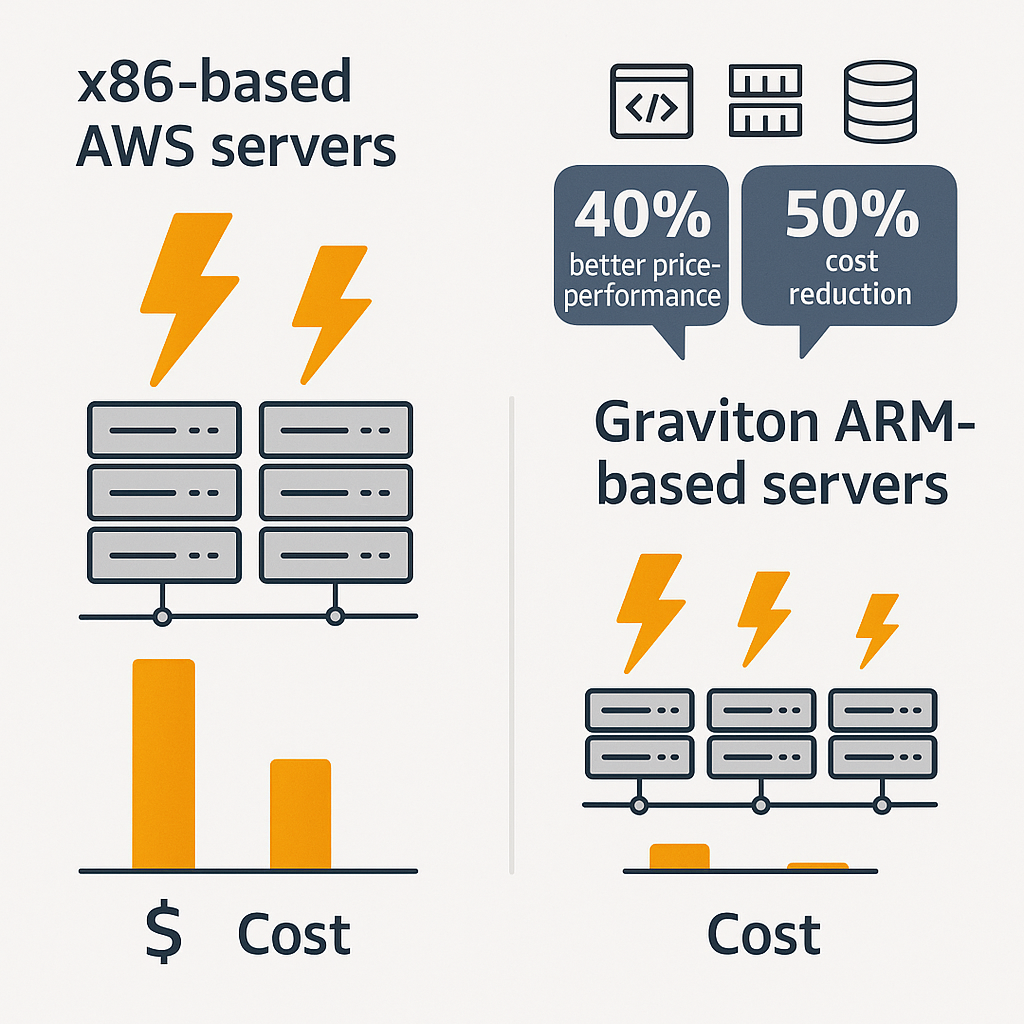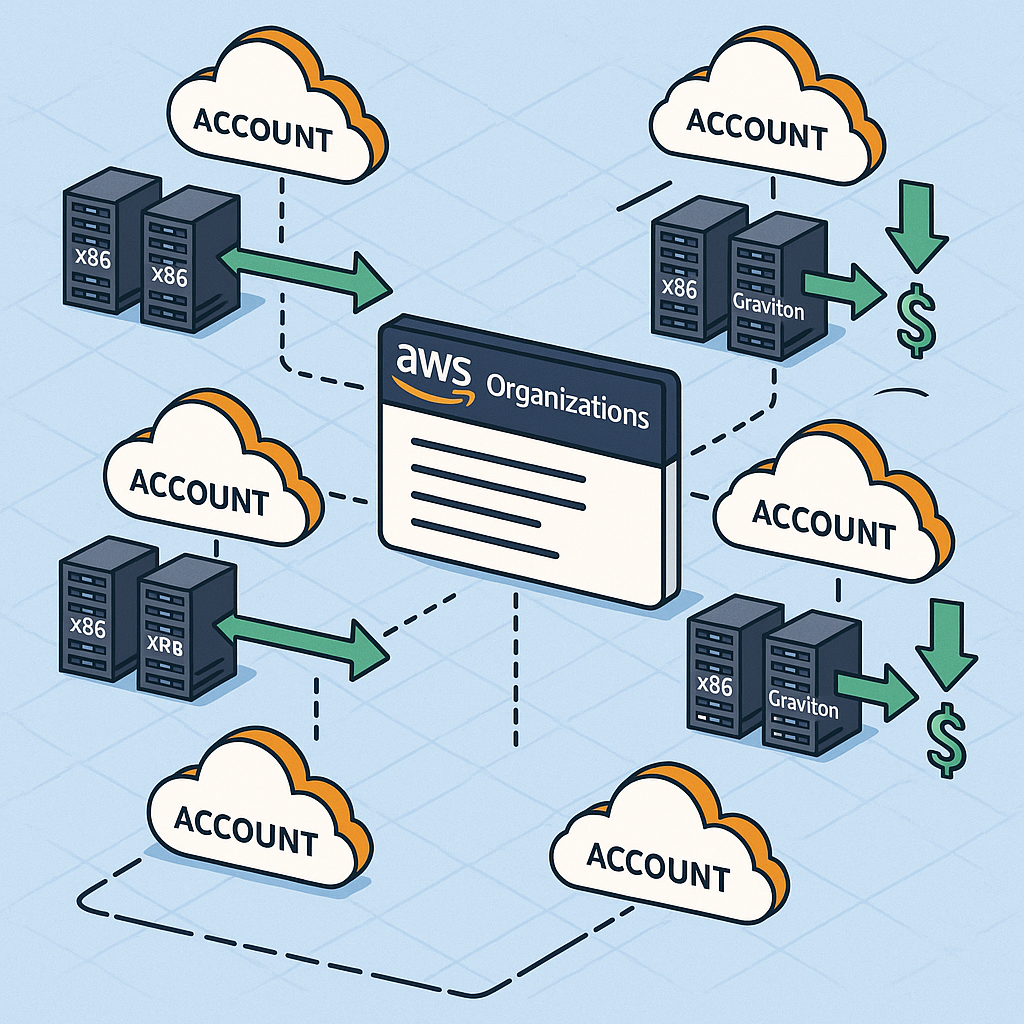Maximizing AWS Cost Savings with Graviton Instances in Multi-Account Environments
Are you missing out on significant AWS cost reductions while maintaining or even improving performance? AWS Graviton instances—powered by AWS’s custom ARM-based processors—have emerged as a game-changing option for organizations seeking to optimize their cloud spending without compromising workload efficiency.
The Graviton Cost Advantage: A Financial Breakthrough
AWS Graviton instances deliver impressive price-performance benefits compared to traditional x86-based options:

- 40% better price-performance versus comparable x86 instances (Intel/AMD) for web servers, containers, and microservices
- Up to 60% lower energy consumption, allowing AWS to pass these savings directly to customers through reduced pricing
- Potential 50% cost reduction when migrating comparable workloads from Intel to Graviton (e.g., $91K versus $182K annually)
These aren’t just theoretical numbers. Real organizations are seeing tangible benefits:
“GOV.UK achieved 15% per-instance savings migrating from m6i (x86) to m7g (Graviton), with total savings reaching 55% when combined with right-sizing and Savings Plans,” according to performance benchmarks from Hykell.
Other organizations like Domo and DoubleCloud have reported 20% price-performance improvements after switching to Graviton-based instances, demonstrating consistent benefits across different use cases.
Amplifying Graviton Savings with Reserved Instances and Savings Plans
While Graviton instances already offer significant baseline savings, combining them with AWS’s commitment-based discount programs creates a powerful cost optimization strategy:
-
Lower base rates enhance discount impact: The inherently lower pricing of Graviton instances means that when you apply Reserved Instance or Savings Plan discounts (40-70%), your effective savings multiply.
-
Mixed instance strategy: Deploy Graviton as your primary instances in auto-scaling groups with x86 instances as fallbacks to balance cost efficiency with availability requirements.
-
Compound savings approach: As demonstrated by GOV.UK’s experience, combining Graviton migration with right-sizing and Savings Plans can push total savings to 55% or higher.
For CPU-bound and disk-bound workloads, industry analysis confirms a 15-25% cost advantage when using Graviton, making these instances particularly attractive for organizations with tight cloud budgets.
Multi-Account Optimization: Maximizing Graviton Benefits Across Your Organization
For enterprises managing multiple AWS accounts, implementing Graviton effectively requires a strategic approach:

1. Cross-Account Assessment and Migration Planning
Before diving in, conduct a thorough assessment across all accounts to identify:
- Graviton-ready workloads: Applications built on languages with mature ARM64 support (Python, Java, Node.js, Go)
- Migration complexity: Categorize workloads based on expected migration effort and compatibility with AWS Graviton
- Potential savings impact: Calculate the cost reduction potential across your organization
Use AWS Cost Explorer with appropriate tagging to identify your highest-spend instance types and prioritize those for Graviton migration assessment.
2. Strategic Workload Distribution
Different workloads have different requirements. Distributing them optimally across your instance types can maximize savings:
- Memory-intensive applications: Deploy on R7g Graviton instances
- Compute-heavy workloads: Utilize C7g Graviton instances
- General-purpose applications: Run on M7g Graviton instances
- Legacy or x86-dependent workloads: Keep on Intel/AMD instances temporarily
A financial services company achieved 35% cost savings and 20% better memory throughput after migrating from R5 to R7g instances, demonstrating the real-world impact of strategic workload placement.
When using Kubernetes, you can implement a hybrid approach by creating node groups with both Graviton and x86 instances, allowing for intelligent workload placement based on compatibility and cost-efficiency.
3. EBS Cost Optimization in Graviton Environments
While Graviton doesn’t directly impact EBS pricing, the compute savings create opportunities for broader storage optimization:
- Leverage freed budget: Use the compute savings from Graviton to implement EBS optimization strategies
- Modernize storage tiers: Upgrade from gp2 to gp3 volumes for both performance improvements and cost reductions
- Centralize storage management: Implement cross-account storage governance to identify and address underutilized EBS volumes
Consider implementing automated lifecycle policies to move infrequently accessed data to cheaper storage tiers, further extending the cost benefits achieved through Graviton adoption.
4. Governance and Consistency Across Accounts
Implementing consistent Graviton adoption across multiple accounts requires:
- AWS Organizations policies: Create Service Control Policies that encourage or mandate Graviton instance usage where appropriate
- Tagging strategy: Implement consistent tagging to track Graviton adoption, migration status, and realized savings
- Automated compliance: Use AWS Config rules to enforce Graviton usage for compatible workloads
Organizations can leverage AWS Organizations’ centralized management to deploy consistent Graviton adoption policies across all member accounts, ensuring standardized cost optimization approaches.
Real-World Performance and Cost Impact
The performance characteristics of Graviton make it particularly well-suited for specific workloads:
-
Web and application servers: Graviton’s efficient ARM instruction set delivers superior throughput for HTTP requests and API calls.
-
Containerized microservices: A media company processing video encoding jobs saw 73% performance improvement on Graviton4 over Graviton2, plus 35% cost reduction.
-
Databases and caching systems: A compute workload example showed annual costs of $91K on Graviton versus $108K on AMD or $182K on Intel instances, according to cost comparison data between Graviton and Intel instances.
However, it’s worth noting that for single-threaded applications, x86 instances may still offer better performance in some cases. This highlights the importance of a nuanced approach to instance selection rather than a one-size-fits-all Graviton migration.
Implementing a Phased Migration Approach
For multi-account environments, a methodical migration approach is crucial:
-
Start with development and non-critical workloads: Build confidence and expertise before moving production systems.
-
Employ canary deployments: Begin with 5-10% of traffic on Graviton instances, gradually increasing while monitoring performance.
-
Update your infrastructure as code: Modify CloudFormation templates and other IaC to support both ARM and x86 architectures during transition.
-
Leverage the AWS Graviton Ready Program: Utilize pre-optimized software and services to simplify migration decisions.
Many organizations find success by targeting their next refresh cycle for Graviton adoption, rather than attempting to migrate all workloads at once. This approach allows for natural integration of Graviton instances as part of your regular infrastructure evolution.
Common Migration Challenges and Solutions
When implementing Graviton across multiple accounts, watch for these common challenges:
-
Software compatibility: Not all applications are ARM-compatible. Understanding software compatibility with AWS Graviton is essential for planning.
-
Performance monitoring baselines: Establish new baselines for Graviton instances as performance characteristics differ from x86.
-
Container image availability: Ensure your container images support ARM64 architecture or implement multi-architecture builds.
-
Team knowledge gaps: Provide training on ARM architecture differences and best practices for Graviton instances.
Organizations can mitigate these challenges by creating a Graviton Center of Excellence team that develops expertise and internal documentation to support migration efforts across different business units and account teams.
Conclusion: Automating Graviton Cost Optimization
While manual migration to Graviton instances can deliver significant savings, achieving optimal and sustained cost efficiency requires automation. Solutions like Hykell provide automated cloud cost optimization that can:
- Continuously identify Graviton migration opportunities across your AWS environment
- Automatically adjust instance configurations to maximize cost-performance benefits
- Monitor and verify realized savings from Graviton adoption
- Extend optimization beyond instances to EBS, networking, and other AWS services
Organizations implementing these strategies routinely achieve 30-40% AWS cost reductions while maintaining or improving application performance. With Graviton instances at the core of your cost optimization strategy, you can transform your AWS spend while keeping your applications running efficiently at scale.
